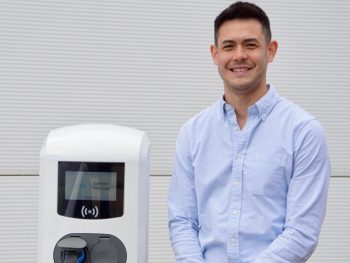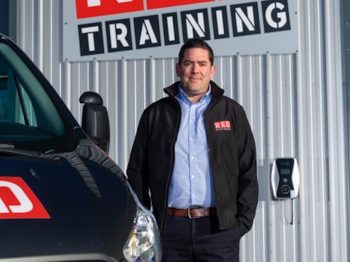2024 is now upon us – and some of the UK’s pre-eminent fleet sector specialists give their views on what the next 12 months have in store for car and van operators.
Rising challenges for service delivery and driver shortages
Beverley Wise, Webfleet regional director for Bridgestone Mobility Solutions

The year ahead presents a myriad of exciting opportunities for fleets, but also some complex challenges that will need to be navigated.
As tech developments advance apace, business customers will continue to expect faster and more flexible service delivery. For fleet operators, meeting this demand calls for ever-smarter processes, which must invariably be supported by fleet management software solutions.
Access to real-time and accurate vehicle and driver insights for informed decision-making, dynamic routing and efficient last-mile delivery will be essential.
Digital systems that improve the working lives of drivers, helping them mitigate stress behind the wheel and better manage their workflow will also be important in helping address a commercial driver shortage, acting as a fillip for skills recruitment and retention.
Elsewhere, stricter environmental regulations can be expected to be a significant factor throughout 2024. Understanding and adhering to the regulatory landscape will be crucial to avoiding penalties and maintaining a positive corporate image. Fleets should consider solutions that support them in the accurate reporting of the CO2 emissions caused by their vehicles, in anticipation of disclosure requirements, such as the UK Sustainability Disclosure Standards (UK SDS).
Greater shifts in cost saving, data security and AI for coming year
David Savage, vice president, UK & Ireland, Geotab

This time last year we were quite enthused about the transition to zero emission vehicles, given the UK’s aggressive and world-leading schedule to complete the shift. However, the recent delay to 2035 has arguably put a damper on the industry, with stagnating demand amongst consumers in particular. Assuming there’s no amendment to government policy, companies will be looking to reassess their electrification strategies. In the shadow of this, and broader economic uncertainty, this year will see greater shifts in cost-saving measures across the board as businesses use the pause to assess data-driven tactics in electrification and plan for the future. This is particularly relevant for the telematics space, where organisations will be looking for significant cost savings, especially in vehicle maintenance and lifecycle extension.
On the subject of electrification, there is a call for greater standardisation in charging infrastructure measurements to simplify understanding for consumers and businesses alike. We’re seeing the emergence of this following the Government’s Public Charge Point Regulations, which seek to standardise critical components of the charging experience such as payment, pricing transparency and open data access. 2024 will see this kicking into gear amongst UK charging networks – not only to simplify comprehension for drivers and fleets but also hopefully go some way to compel further interest in electrification. There is a prevailing expectation of eventual consolidation and standardisation, drawing parallels to the evolution of mobile phones across the EU, and we hope to see the fruits of this soon.
We anticipate the conversations around data security and artificial intelligence (AI) will continue to evolve into 2024. Data security, including GDPR compliance, is becoming increasingly important with a continual need for entities to review the data they ingest. The fleet management industry is creating extensive amounts of data which need to be protected and utilised responsibly. So too with AI, the industry is experiencing heightened interest in how it can enhance and optimise the fleet management world. Of course, this is associated with numerous implementation challenges, particularly its integration across various data sources. Beyond insight inference, these larger datasets will begin to be used for additional purposes such as the ‘gamification’ of data to drive employee engagement and positively influence driver behaviour.
2024 to see evolving OEM environment and rising role for fleet data
Rory Mackinnon, sales and marketing director, Holman

The availability of data is greater than ever before, and this trend will only continue in 2024. Customers now need to be able to access that data in a way that allows for actions to be taken to improve the running of their fleet from both an efficiency and cost saving perspective; it’s the role of businesses such as Holman to be able to support this opportunity for our customers.
While the Government has moved out the zero emissions deadline to 2035, there is still a keen focus from customers to drive their fleet sustainability forward. But there is a challenge around infrastructure that will get worse before it gets better, and customers will need a fleet supplier that will be able to support their needs today but with an eye on their future sustainability goals.
Finally, the OEM market in the UK and Europe has been fairly consistent for the last decade, but in 2023 we have seen many new entrants into this space, especially from China. This trend will continue in 2024 and play a bigger part for fleet decision-makers – this is good news for drivers and fleet managers who now have more choice than ever before.
Last-mile delivery transformation in 2024
Nick Guise, group marketing manager at Trakm8

As we enter 2024, the last-mile delivery landscape is witnessing a profound transformation, with AI fleet optimisation solutions at the forefront of innovation. Focused on achieving excellence in last-mile delivery, flexible and scalable algorithms are reshaping how the industry approaches cost management and sustainability.
AI Optimisation solutions address the challenge of escalating fleet costs while meeting the growing consumer demand for sustainable deliveries. Enabling customers to book delivery slots and optimising delivery schedules, these solutions play a crucial role in reducing last-mile delivery failures and ensuring timely customer fulfilment, thereby enhancing the overall online shopping experience.
AI Optimisation technology promises a host of benefits for fleets, including significant reductions in fuel and labour costs, decreased total fleet mileage, the ability to handle increased order volume without requiring additional shifts or vans, and notable improvements in miles per drop. This translates to substantial savings in emissions, fuel expenses, and overall operational costs, making it a transformative solution for efficient and cost-effective fleet management.
Insurance to bring big challenges
Paul Hollick, managing director, Lightfoot

Insurance is going to be a big, and costly, issue for businesses to grapple with in 2024 as a number of factors combine to create rocketing premiums.
With premiums rising by up to 30%, we are hearing from lots of fleets who are struggling to keep a lid on insurance costs, even if they have excellent safety records.
Inflationary pressures, a lack of parts and a shortage of technicians are the key drivers behind the price rises, but there are other factors at play too – it only takes one electric vehicle to be written off, or a new battery pack required, to put a fleet’s policy into the red.
Gone are the days where you could demonstrate that your fleet risk is reducing and therefore expect a reduction in your premium. The best that you can hope for is that your increases are smaller.
What customers are saying is that it’s becoming more and more important to be able to put together a package of convincing measures that prove to the underwriter that your fleet risk is reducing; be that through installing lights or dash cameras or demonstrating what you are doing with that data to manage your risk.
Innovations in fleet management to support net zero goals
Aliaksandr Kuushynau, head of Wialon division with fleet software developer Gurtam

We are seeing an emerging trend towards the integration of OEM (original equipment manufacturer) telematics and aftermarket telematics systems. Historically, these systems have functioned on separate platforms, leading to fragmentation in the way vehicle data is collected, analysed and utilised. By bringing all data together onto unified platforms, such as Wialon, the industry can leverage a more holistic view of vehicle performance, driver behaviour and operational efficiency.
Deeper integration of EV data into fleet management platforms is a significant step towards decarbonisation and net zero goals. The evolution of fleet management platforms to support the electrification of fleets is a critical development, as it not only aids in reducing carbon emissions but also supports organisations in achieving their environmental goals in a practical and effective manner.
Rise of driver-friendly technologies: The integration of driver-friendly AI and Advanced Driver Assistance Systems (ADAS), along with video telematics, reduces the cognitive load on drivers, with features like traffic updates, route optimisation and voice-activated controls becoming essential. Familiarising drivers now with these technologies will likely lead to a smoother transition to more automated systems in the future.
Introduction of AI technologies to multiple processes of fleet management, such as route planning, predictive maintenance or fleet safety management, as well as decision-making. AI can process vast amounts of data to provide fleet managers with actionable insights, helping them make informed decisions on vehicle utilisation, cost analysis and compliance with environmental and safety regulations. Furthermore, AI is instrumental in managing the complexities of modern fleets, especially as they transition to include electric and autonomous vehicles.
A call for a realistic approach to EV fleet adoption
Adam Hall, energy services director at Drax Electric Vehicles

While 2023 was a positive year for the EV industry, 2024 will be somewhat more challenging.
The tough financial climate last year has meant that many fleet-operating businesses, which have long been the driving force behind the nation’s transition to electric, have had to cut back on larger-scale sustainability projects. This isn’t to say that they’re any less determined to make a real difference towards net zero; it just means that they’ll need to record from the financial hits of the past few years before committing to high-investment projects.
However, as we saw during the pandemic, the EV industry is extremely resilient to economic ups and downs. As such, we should fully expect more major milestones over the next 12 months, particularly as we see the rollout of lower-cost models.
Decarbonisation plans to accelerate in 2024
Damian Penney, vice president EMEA at Lytx

COP28 saw a landmark moment as nearly 200 nations agreed to transition away from fossil fuels. While the fleet industry has certainly placed a greater emphasis on lowering emissions, global environmental pressures and commercial implications for businesses mean we can expect to see decarbonisation plans accelerate in 2024.
The first solution that springs to mind for many is to switch to greener sources of fuel. This offers great potential in the long-term, but the majority of these solutions are not yet ready for mass adoption by commercial fleets.
Fleets are likely to see more of an impact if they focus their efforts on incremental efficiencies, which offer a faster, less disruptive and more cost-effective route to lowering emissions. There are several ways to achieve this efficiency-led approach – including through optimised route planning, regular vehicle maintenance, driver training and incident reduction.
Naturally, drivers and fleet managers require the tools and technology to unlock these efficiency gains. Video telematics platforms and intelligent dash cams, which are equipped with machine vision and artificial intelligence, stand at the forefront of incident prevention and driver training, as well as data collation and interpretation. As such, these technologies have a pivotal role to play in enabling the commercial fleet industry to reach its sustainability goals.
Fleets investing in technology and IoT platforms to lead way in EV switch
Philip van der Wilt, SVP and GM EMEA of Samsara

Physical operations will continue to be challenged by the uncertainty surrounding fleet electrification and the need to double down on fuel efficiency.
Businesses are waking up to the fact that it’s not petrol, diesel or electricity that powers fleets – it’s data.
Those who have already invested in technology and IoT platforms to manage their fleets are already better off. Fleets that have already invested in connected data platforms are better able to identify which routes, vehicles, and tasks are best suited to the electrification of their fleets.
They’re also using these same fuel-agnostic systems to identify other technologies that will lead to fleet decarbonisation.
It’s now up to the rest of the industry to play catch-up or risk being hit with a double whammy – falling behind on electrification plans while being unable to manage sprawling fuel costs.
New approaches to driver training
Greg Ford, head of corporate, RED Corporate Driver Training

With rocketing insurance premiums, we’re expecting more fleets to look into systematic ways of reducing their driver risk liability – but businesses need to ensure it’s not just a box-ticking exercise. The potential solutions, such as our SafetyFirst system, need to be targeted correctly to achieve the best outcomes.
We also believe that 2024 will have less of an EV focus than previous years – with demand dropping and the ICE ban delayed until 2035, we expect more businesses to be investing in ways of making their existing ICE fleet as efficient as possible through courses such as Fuelsave.
Grey fleet remains a growing issue of concern, with more businesses reducing their company car offering and moving to a cash for car solution. Companies must recognise that they still have an obligation to ensure roadworthiness and driver competency even if an employee is driving their own vehicles.
Finally, we’re hoping for less public sector service disruption to allow our sector to clear the backlog of professional driving tests.


